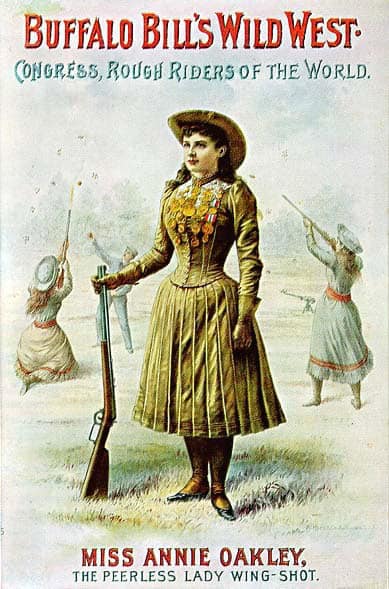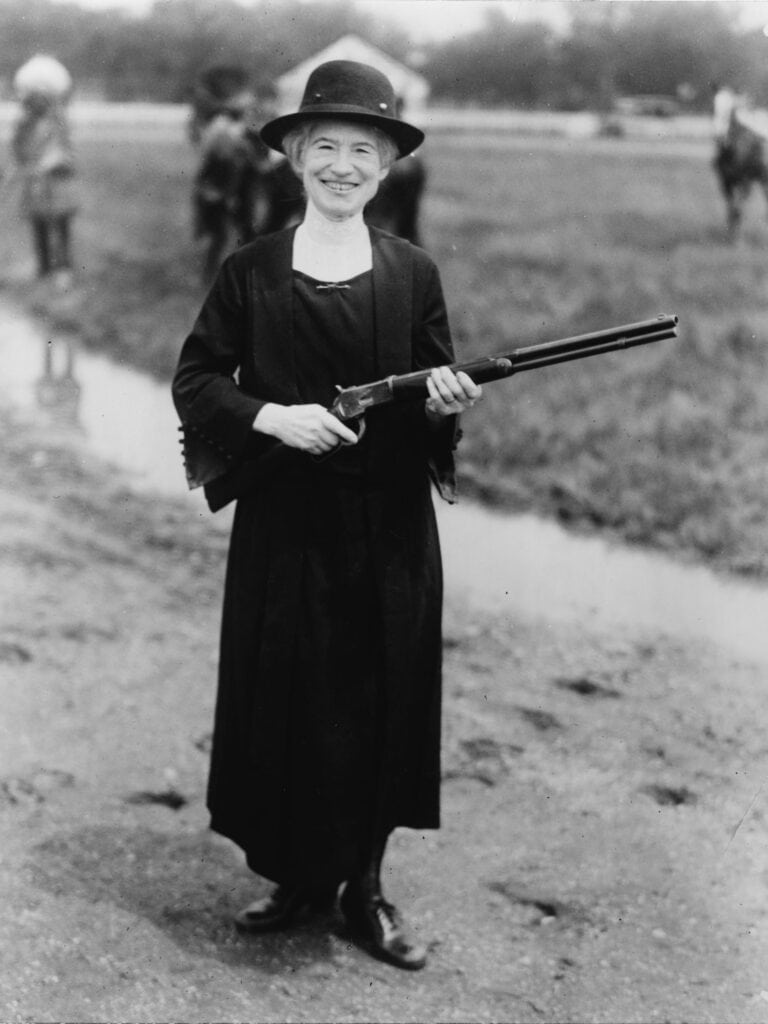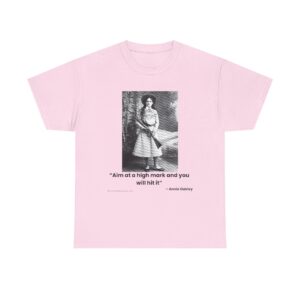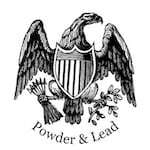
Annie Oakley remains one of the most iconic figures in American history. She was more than a sharpshooter; she was a cultural phenomenon who redefined what a woman could accomplish in a world dominated by men. Her unparalleled skill with firearms, her pioneering spirit, and her grace under pressure transformed her into a symbol of courage and precision whose name endures well over a century later. This is the complete story of the woman who became “Little Sure Shot.”
Early Life and Humble Beginnings
Annie Oakley was born Phoebe Ann Mosey on August 13, 1860, in a log cabin in Darke County, Ohio. Her family lived in poverty, and her childhood was marked by hardship. Her father, Jacob Mosey, was a veteran of the War of 1812, and her mother, Susan Wise Mosey, struggled to raise seven children after his death when Annie was just six years old. To survive, the young Annie learned to shoot at an early age. She used her father’s old percussion rifle to hunt small game, selling her kills to local grocers, hotels, and restaurants in nearby Greenville. By the age of twelve she was supporting her family through the sale of wild game, earning enough to pay off the mortgage on her mother’s farm.
Her natural talent for shooting was evident almost immediately. She practiced by sighting along fence posts and tree branches, learning to judge wind and distance by instinct. By the time she was a teenager, she had already become a local legend for her marksmanship. Annie’s accuracy was so refined that she could consistently hit the eye of a squirrel or split a playing card edgewise from a distance. This skill would eventually lift her from obscurity and place her among the great performers of her age.
Rise to Fame and the Buffalo Bill Connection

Annie Oakley’s life took a dramatic turn in 1875 when she competed against a marksman named Frank E. Butler in a shooting contest in Cincinnati. Butler, a professional exhibition shooter from New Orleans, was touring with a traveling show and had challenged local marksmen wherever he performed. To his surprise, the fifteen-year-old Annie outshot him, hitting all twenty-five targets while Butler missed one. Impressed not only by her skill but by her quiet confidence, Butler soon fell in love with her. They married the following year in 1876, forming one of the most enduring partnerships in show business.
The couple performed together for nearly a decade before Annie joined Buffalo Bill Cody’s Wild West show in 1885. This was the opportunity that would catapult her to international fame. Under the stage name “Annie Oakley,” she quickly became one of the main attractions, astonishing audiences with her speed, precision, and grace. Her ability to shoot targets while riding a horse, to fire backward using mirrors, and to hit coins tossed into the air made her a sensation wherever the show traveled.
Buffalo Bill recognized Annie Oakley's immense talent and gave her a prominent place in the company’s lineup. It was the Lakota leader Sitting Bull, however, who affectionately nicknamed her “Little Sure Shot” after witnessing her shoot with unerring accuracy at Fort Bennett, Dakota Territory. The two developed mutual respect and friendship, and he symbolically adopted her as his daughter. The nickname remained with her for the rest of her life.
International Stardom and Royal Recognition
During her years with Buffalo Bill’s Wild West, Annie Oakley performed before countless audiences across North America and Europe. Between 1887 and 1892 she participated in tours through England, France, Italy, and Germany, introducing European crowds to the excitement of frontier marksmanship. Her exhibitions were attended by royalty including Queen Victoria, King Umberto I of Italy, and Kaiser Wilhelm II of Germany. At the Queen’s Golden Jubilee in 1887 she performed before a crowd of 200,000 spectators at London’s American Exhibition, drawing gasps of admiration as she shattered glass balls in midair with a .22 caliber rifle.
One of Annie Oakley's most famous demonstrations occurred in Berlin when she shot the ash from a cigarette held in the mouth of Kaiser Wilhelm II, using a .22 caliber Marlin lever-action rifle. The act became a legend, especially after World War I, when humorists suggested that history might have changed had she missed.
Annie Oakley’s performances were not merely displays of marksmanship but of character and professionalism. She maintained decorum, refused coarse stage costumes, and insisted on tailored garments designed for practicality and modesty. Her poise and self-discipline set her apart from the rougher image of the frontier performer, making her acceptable to audiences who might otherwise have dismissed a woman handling firearms as unladylike.
Advocate for Women and Marksmanship Training
Beyond her fame as a performer, Annie Oakley became a dedicated advocate for women’s empowerment through self-defense and shooting sports. She believed that familiarity with firearms could make women more confident, independent, and safe. Over the course of her life she personally instructed an estimated fifteen-thousand women in shooting and firearm safety, often free of charge. She taught them to respect the weapon, to focus on technique and control, and to see skill as a form of equality rather than aggression.
Her advocacy extended to the military. In 1898, at the outbreak of the Spanish-American War, she wrote to President William McKinley offering to raise a regiment of fifty women sharpshooters who could serve as scouts and marksmen. Although her offer was politely declined, it underscored her patriotism and her belief that women could serve their nation with the same discipline and courage as men.
She also supported marksmanship education for children, working with the Union Metallic Cartridge Company and the Stevens Arms Company to promote responsible shooting instruction. Her name became synonymous with accuracy, and many firearms manufacturers used her image in advertising campaigns that presented shooting as a sport for families rather than a symbol of violence.
Tools of Her Trade

Annie Oakley’s arsenal reflected both craftsmanship and precision. Among her favored weapons were the Stevens Model 44 .22 rifle, which she used for exhibition trick-shooting; a Parker Brothers 12-gauge side-by-side shotgun for clay targets; and a Marlin Model 1891 lever-action rifle chambered in .22 Long Rifle. She also used custom-built rifles from the Remington Arms Company, engraved and inlaid with silver, as well as pistols from Colt and Smith & Wesson for rapid-fire exhibitions. Her firearms were finely balanced and meticulously maintained, often shortened slightly to fit her smaller frame.
Her best-recorded feats of marksmanship astonished even professional shooters. Contemporary reports document her breaking twenty-five clay targets in twenty-seven seconds using a Parker shotgun, splitting a playing card edgewise at thirty paces and then putting five more holes through it before it hit the ground, and shooting over a mirror to strike the center of an ace of hearts behind her back. These were not exaggerated stories but repeatable exhibitions witnessed by hundreds of spectators.
Trials, Accidents, and Triumphs
Despite her fame, Annie Oakley’s life was marked by physical trials and professional challenges. On March 20, 1901, while traveling with the Buffalo Bill show, a train collision near Linwood, North Carolina, severely injured her spine and right leg. The accident ended her active touring with Cody’s company, yet her determination never faltered. After a long recovery she began performing in smaller venues and later with The Young Buffalo Show, still capable of remarkable precision and speed.
In 1904 her reputation faced another threat when a fabricated newspaper story claimed she had been arrested for stealing to support a cocaine habit. The report, published by The Chicago Tribune and syndicated nationally, was entirely false. Annie Oakley, outraged, pursued legal action against fifty-five newspapers and won fifty-four of the cases. Her dogged defense of her integrity restored her public image and displayed her moral courage as clearly as her marksmanship had shown her physical skill.
Later Years and Lasting Legacy

After leaving full-time touring, Annie Oakley continued to perform in exhibitions and teach shooting. She and Frank Butler lived for several years in Nutley, New Jersey, then moved to Pinehurst, North Carolina around 1912, where she participated in shooting tournaments and instructed beginners. They later relocated to Cambridge, Maryland, before returning to Greenville, Ohio, in their final years. Oakley remained active in charity work, raising funds for orphanages and for veterans’ relief programs. She also gave free marksmanship demonstrations for girls’ schools, encouraging discipline and sportsmanship.
Even into her sixties she could still perform astonishing feats. At age 62 she set a record by hitting one hundred clay targets in a row at a public exhibition in Pinehurst. Observers remarked that her precision seemed undiminished by time.
Annie Oakley died on November 3, 1926, in Greenville, Ohio, at the age of sixty-six. Her beloved husband Frank Butler followed her only eighteen days later. Their ashes were interred together in Brock Cemetery near Greenville, symbolizing the inseparable partnership that had carried them from poverty to world acclaim.
The Enduring Image of “Little Sure Shot”
Annie Oakley’s influence extended far beyond her lifetime. She became the subject of biographies, stage musicals, and films, most notably Annie Get Your Gun, which brought her story to mid-twentieth-century audiences. Yet behind the theatrical embellishments lies a woman of substance and discipline who represented the finest qualities of the American frontier. Her story blended humility with excellence and transformed marksmanship into an art form that commanded respect across continents.
Her records remain remarkable. She could split a playing card on edge at thirty paces, shoot a dime tossed into the air, or knock out a candle flame with a bullet. These were demonstrations of mastery born from decades of practice and a perfectionist’s temperament. Oakley proved that marksmanship was not brute force but coordination, focus, and calm precision. She elevated the rifle and the shotgun to instruments of artistry.
Annie Oakley’s Legacy in Modern America
Today, Annie Oakley is remembered not only as the finest female sharpshooter who ever lived but also as a visionary for women’s participation in sports and personal defense. The Annie Oakley Festival in Greenville, Ohio, continues to celebrate her life every summer with marksmanship competitions, exhibitions, and historical displays. Her preserved firearms, medals, and costumes are held by the Buffalo Bill Center of the West in Cody, Wyoming, and by the National Cowgirl Museum and Hall of Fame in Fort Worth, Texas. Each artifact carries the weight of a life defined by precision and dignity.
Modern shooting instructors and competitive shooters still refer to Oakley’s style as a model of form and focus. She taught shooters to keep both eyes open, to follow through the target, and to maintain balance—techniques now standard in professional training. Her advocacy for women’s marksmanship anticipated the later establishment of programs such as the Women’s Shooting League and the Girl Scouts’ rifle badges, both of which cite her as an inspiration.
Her humility was legendary. Despite earning more than any other performer in Buffalo Bill’s troupe except Cody himself, she donated much of her income to charity and preferred a quiet domestic life when off the road. She avoided scandal and never exaggerated her exploits. Even her wardrobe, consisting of finely made yet modestly cut garments, became a symbol of her respect for her craft and her audience.
Conclusion
Annie Oakley’s life was a remarkable journey from poverty to global fame, from a small girl with a rifle in the woods of Ohio to the world’s most celebrated markswoman. She lived with integrity, worked with relentless discipline, and left behind a legacy that continues to resonate across generations. Her name stands as a symbol of precision, perseverance, and power.
For those seeking an enduring figure of American excellence, Annie Oakley remains unmatched. She was a trailblazer who shattered conventions, an artist who turned marksmanship into poetry, and a humanitarian who used her gifts to uplift others. Over a century after her death, her story continues to inspire, proving that true greatness is forged not by circumstance but by spirit.
Read more about Annie Oakley here:


If you know of any forums or sites that should be referenced on this listing, please let us know here.
-

“Aim at a High Mark” — Annie Oakley Tribute T-Shirt — Confidence. Grace. Precision.
Price range: $15.83 through $21.98 Select options This product has multiple variants. The options may be chosen on the product page




